Abstract
Evidence for transcellular bacterial metabolism of phagocyte-derived arachidonic acid was sought by exposing human blood polymorphonuclear leukocytes, prelabelled with [3H]arachidonic acid, to opsonized, stationary-phase Pseudomonas aeruginosa (bacteria-to-phagocyte ratio of 50:1) for 90 min at 37 degrees C. Control leukocytes were stimulated with the calcium ionophore A23187 (5 microM) for 5 min. Radiochromatograms of arachidonic acid metabolites, extracted from A23187-stimulated cultures and then separated by reverse-phase high-performance liquid chromatography, revealed leukotriene B4, its omega-oxidation products, and 5-hydroxy-eicosatetraenoic acid. In contrast, two major metabolite peaks, distinct from known polymorphonuclear leukocyte arachidonic acid products by high-performance liquid chromatography or by thin-layer chromatography, were identified in cultures of P. aeruginosa with [3H]arachidonic acid-labelled polymorphonuclear leukocytes. Respective chromatographic characteristics of these novel products were identical to those of two major metabolite peaks produced by incubation of stationary-phase P. aeruginosa with [3H]arachidonic acid. Production of the metabolites was dependent upon pseudomonal viability. UV spectral data were consistent with a conjugated diene structure. Metabolism of arachidonic acid by P. aeruginosa was not influenced by the presence of catalase, superoxide dismutase, nordihydroguaiaretic acid, ethanol, dimethyl sulfoxide, or ferrous ions but was inhibited by carbon monoxide, ketoconazole, and 1,2-epoxy-3,3,3-trichloropropane. Our data suggest that pseudomonal metabolism of polymorphonuclear leukocyte-derived arachidonic acid occurs during phagocytosis, probably by enzymatic epoxidation and hydroxylation via an oxygenase. By this means, potential proinflammatory effects of arachidonic acid or its metabolites may be modulated by P. aeruginosa at sites of infection in vivo.
Full text
PDF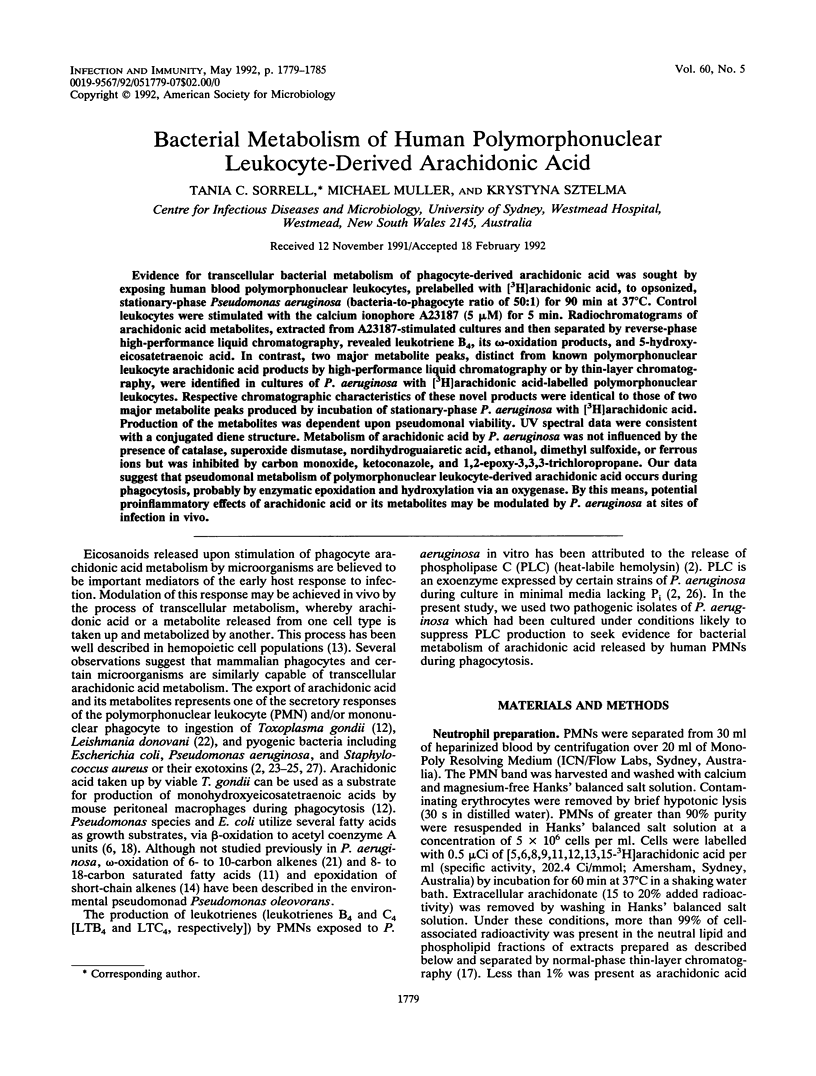
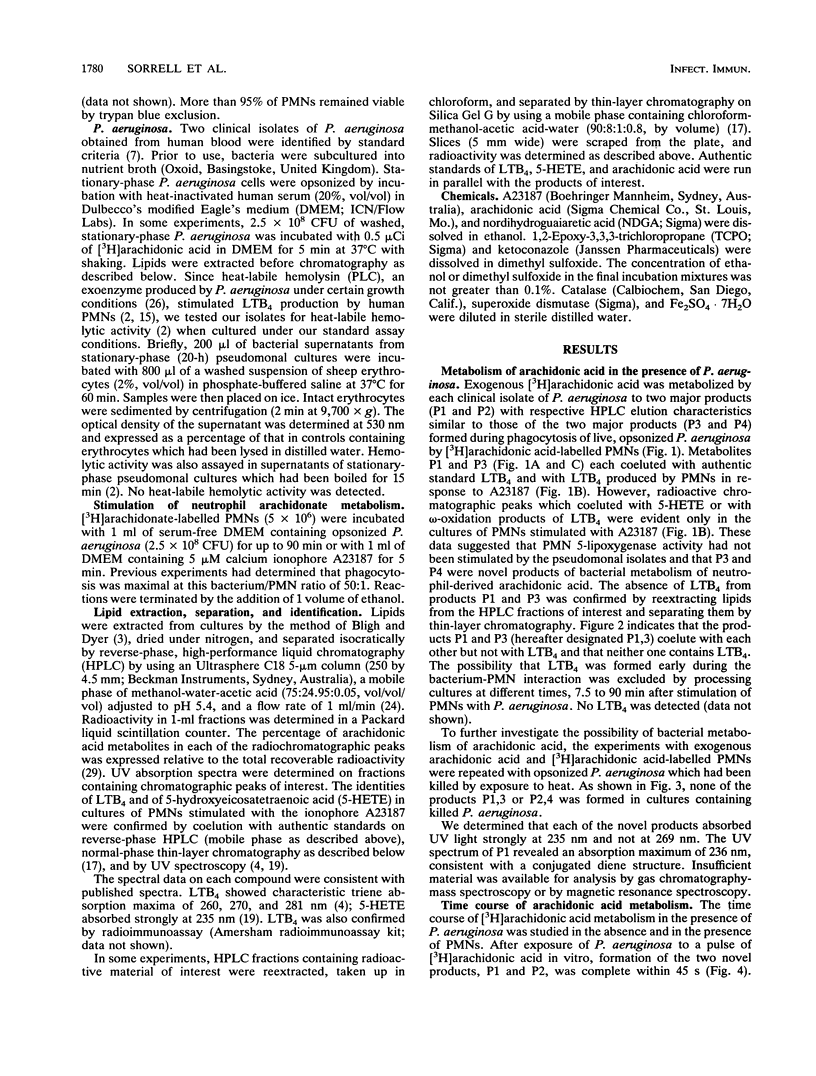
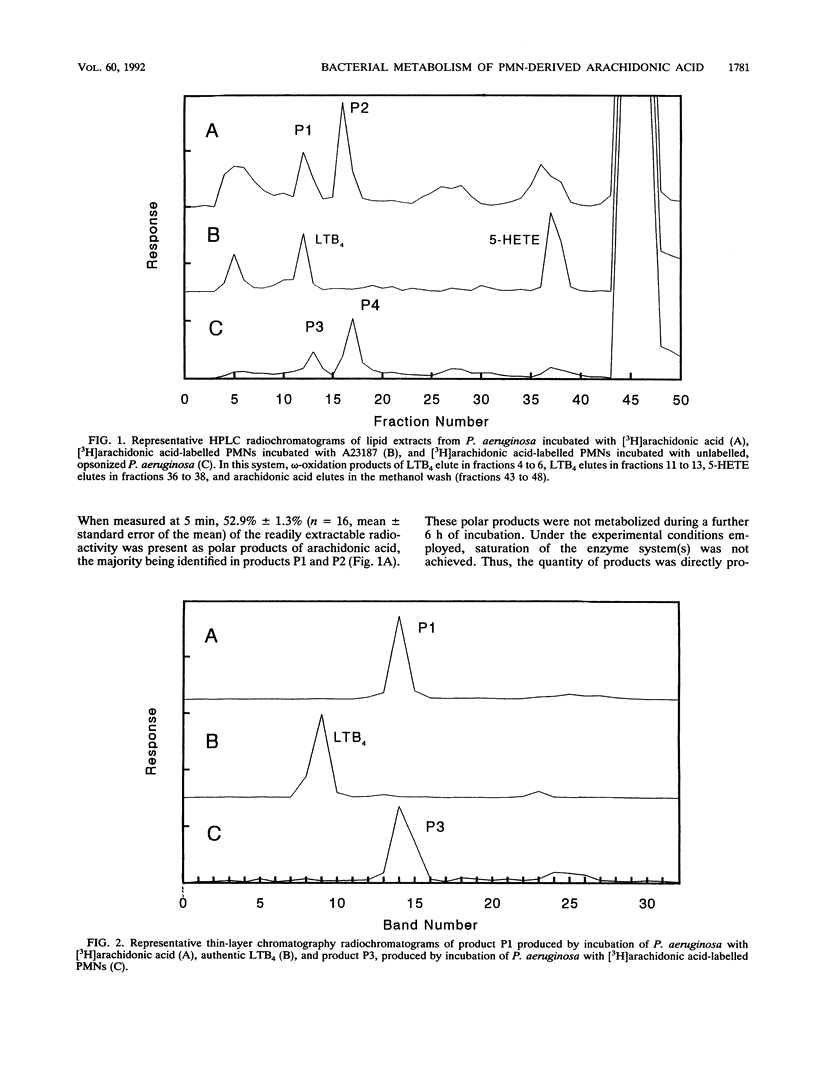
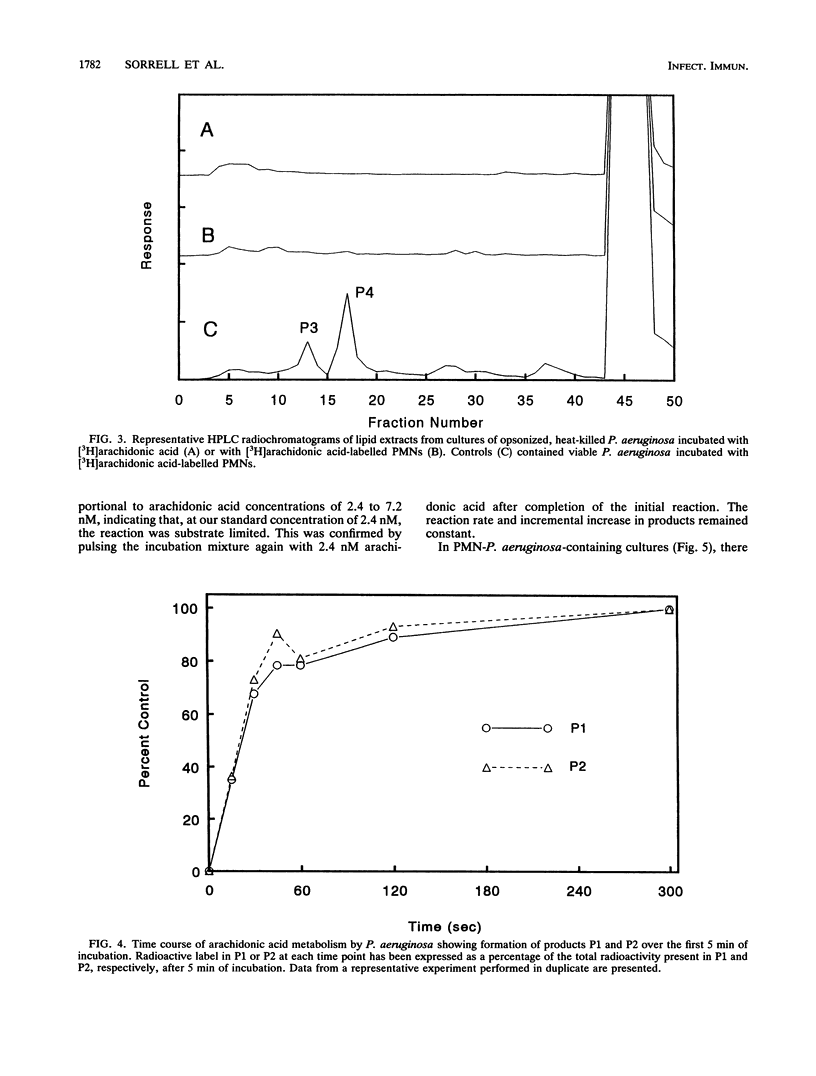
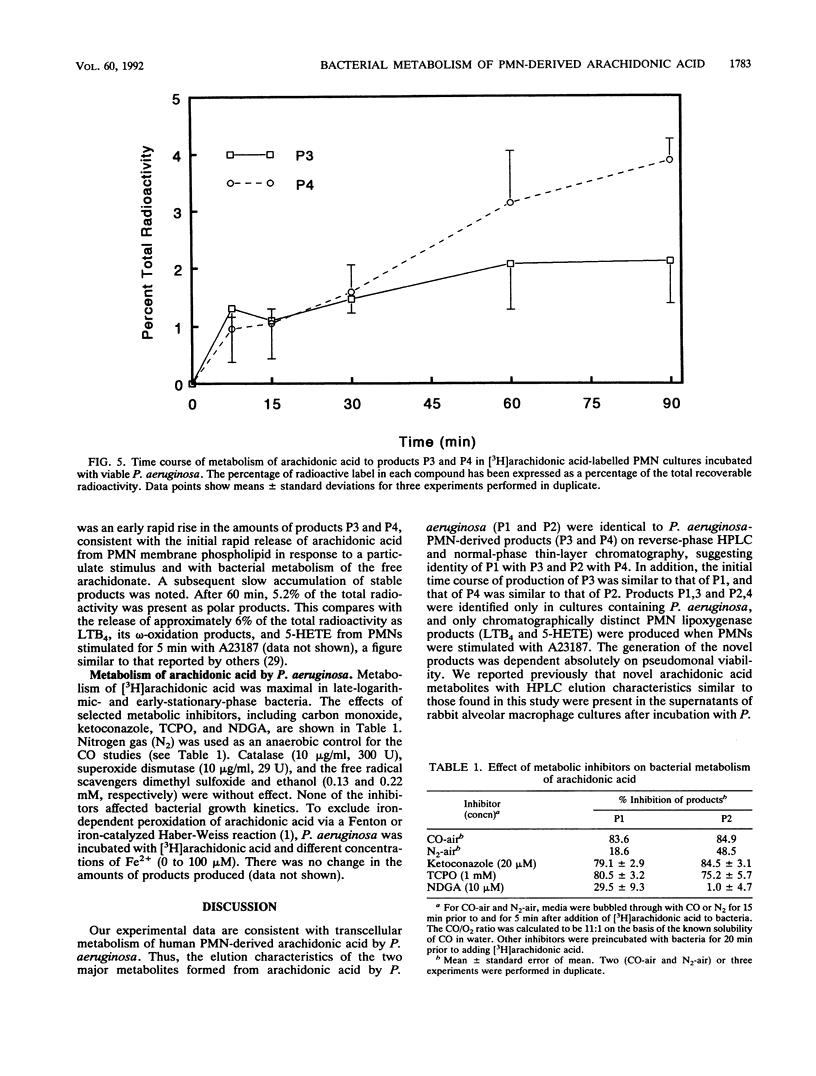
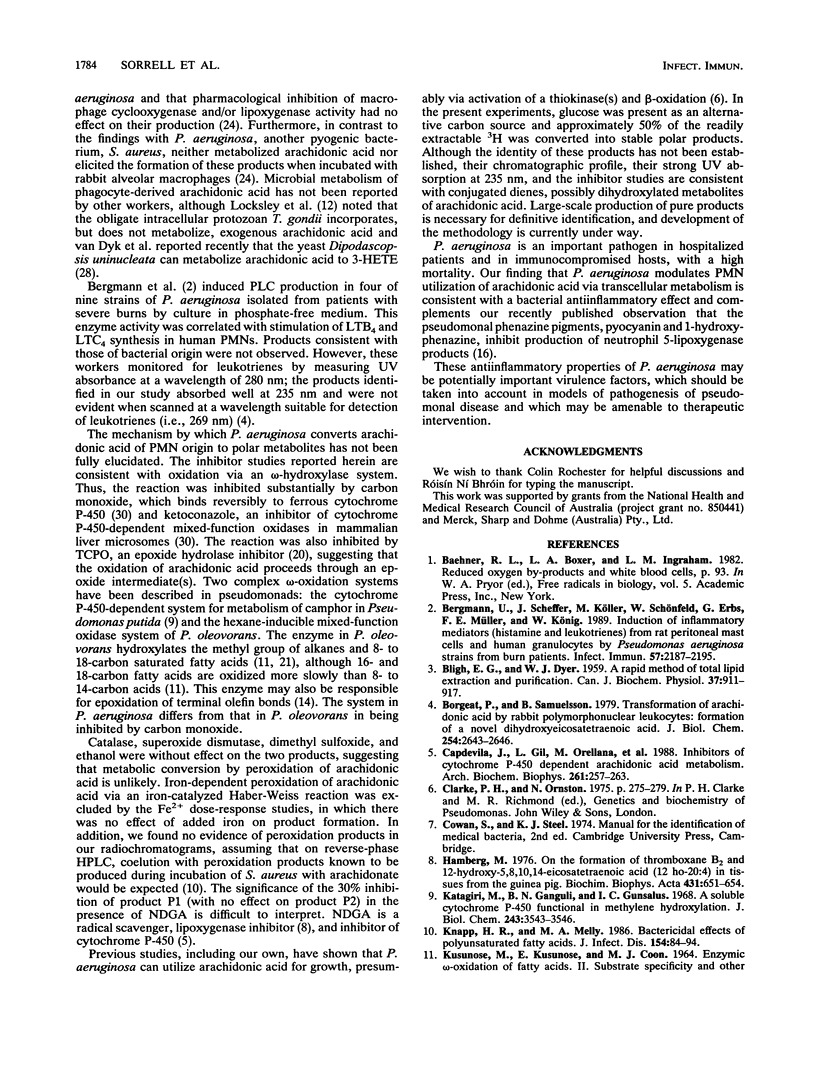
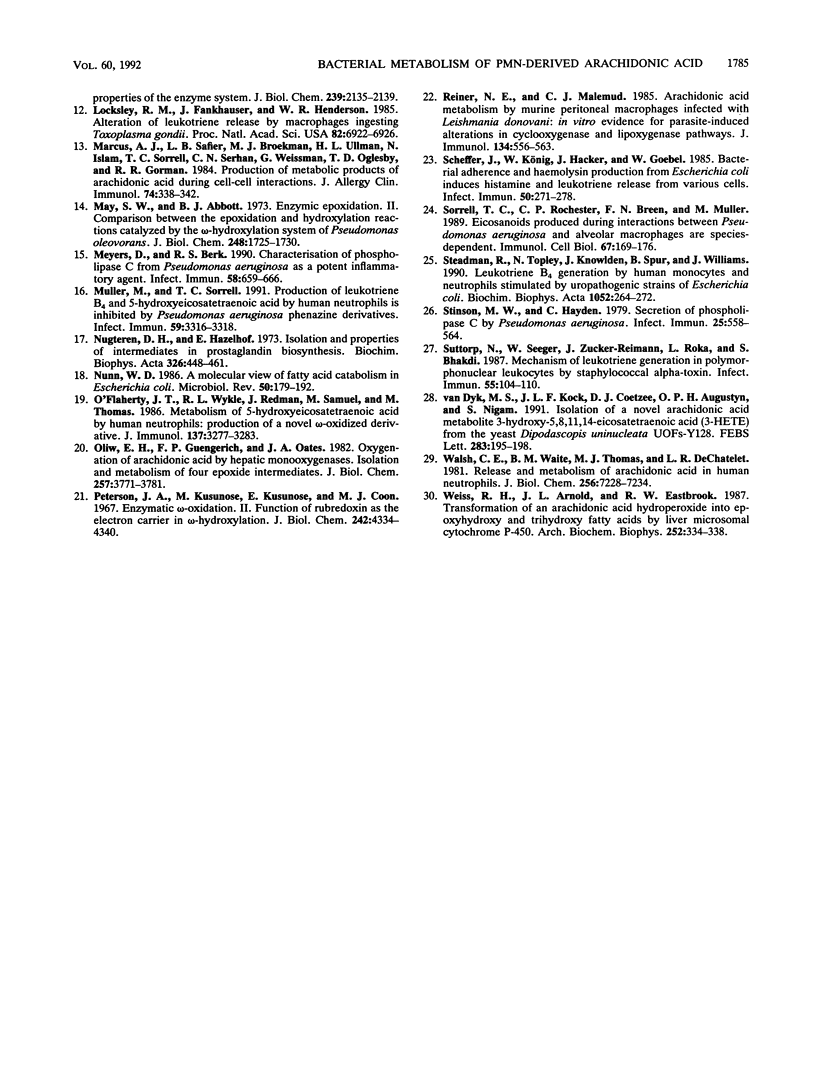
Selected References
These references are in PubMed. This may not be the complete list of references from this article.
- BLIGH E. G., DYER W. J. A rapid method of total lipid extraction and purification. Can J Biochem Physiol. 1959 Aug;37(8):911–917. doi: 10.1139/o59-099. [DOI] [PubMed] [Google Scholar]
- Bergmann U., Scheffer J., Köller M., Schönfeld W., Erbs G., Müller F. E., König W. Induction of inflammatory mediators (histamine and leukotrienes) from rat peritoneal mast cells and human granulocytes by Pseudomonas aeruginosa strains from burn patients. Infect Immun. 1989 Jul;57(7):2187–2195. doi: 10.1128/iai.57.7.2187-2195.1989. [DOI] [PMC free article] [PubMed] [Google Scholar]
- Borgeat P., Samuelsson B. Transformation of arachidonic acid by rabbit polymorphonuclear leukocytes. Formation of a novel dihydroxyeicosatetraenoic acid. J Biol Chem. 1979 Apr 25;254(8):2643–2646. [PubMed] [Google Scholar]
- Capdevila J., Gil L., Orellana M., Marnett L. J., Mason J. I., Yadagiri P., Falck J. R. Inhibitors of cytochrome P-450-dependent arachidonic acid metabolism. Arch Biochem Biophys. 1988 Mar;261(2):257–263. doi: 10.1016/0003-9861(88)90340-2. [DOI] [PubMed] [Google Scholar]
- Hamberg M. On the formation of thromboxane B2 and 12l-hydroxy-5,8,10,14-eicosatetraenoic acid (12 ho-20:4) in tissues from the guinea pig. Biochim Biophys Acta. 1976 Jun 22;431(3):651–654. doi: 10.1016/0005-2760(76)90232-0. [DOI] [PubMed] [Google Scholar]
- KUSUNOSE M., KUSUNOSE E., COON M. J. ENZYMATIC OMEGA-OXIDATION OF FATTY ACIDS. II. SUBSTRATE SPECIFICITY AND OTHER PROPERTIES OF THE ENZYME SYSTEM. J Biol Chem. 1964 Jul;239:2135–2139. [PubMed] [Google Scholar]
- Katagiri M., Ganguli B. N., Gunsalus I. C. A soluble cytochrome P-450 functional in methylene hydroxylation. J Biol Chem. 1968 Jun 25;243(12):3543–3546. [PubMed] [Google Scholar]
- Knapp H. R., Melly M. A. Bactericidal effects of polyunsaturated fatty acids. J Infect Dis. 1986 Jul;154(1):84–94. doi: 10.1093/infdis/154.1.84. [DOI] [PubMed] [Google Scholar]
- Locksley R. M., Fankhauser J., Henderson W. R. Alteration of leukotriene release by macrophages ingesting Toxoplasma gondii. Proc Natl Acad Sci U S A. 1985 Oct;82(20):6922–6926. doi: 10.1073/pnas.82.20.6922. [DOI] [PMC free article] [PubMed] [Google Scholar]
- Marcus A. J., Safier L. B., Broekman M. J., Ullman H. L., Islam N., Sorrell T. C., Serhan C. N., Weissmann G., Oglesby T. D., Gorman R. R. Production of metabolic products of arachidonic acid during cell-cell interactions. J Allergy Clin Immunol. 1984 Sep;74(3 Pt 2):338–342. doi: 10.1016/0091-6749(84)90126-x. [DOI] [PubMed] [Google Scholar]
- May S. W., Abbott B. J. Enzymatic epoxidation. II. Comparison between the epoxidation and hydroxylation reactions catalyzed by the -hydroxylation system of Pseudomonas oleovorans. J Biol Chem. 1973 Mar 10;248(5):1725–1730. [PubMed] [Google Scholar]
- Meyers D. J., Berk R. S. Characterization of phospholipase C from Pseudomonas aeruginosa as a potent inflammatory agent. Infect Immun. 1990 Mar;58(3):659–666. doi: 10.1128/iai.58.3.659-666.1990. [DOI] [PMC free article] [PubMed] [Google Scholar]
- Muller M., Sorrell T. C. Production of leukotriene B4 and 5-hydroxyeicosatetraenoic acid by human neutrophils is inhibited by Pseudomonas aeruginosa phenazine derivatives. Infect Immun. 1991 Sep;59(9):3316–3318. doi: 10.1128/iai.59.9.3316-3318.1991. [DOI] [PMC free article] [PubMed] [Google Scholar]
- Nugteren D. H., Hazelhof E. Isolation and properties of intermediates in prostaglandin biosynthesis. Biochim Biophys Acta. 1973 Dec 20;326(3):448–461. doi: 10.1016/0005-2760(73)90145-8. [DOI] [PubMed] [Google Scholar]
- Nunn W. D. A molecular view of fatty acid catabolism in Escherichia coli. Microbiol Rev. 1986 Jun;50(2):179–192. doi: 10.1128/mr.50.2.179-192.1986. [DOI] [PMC free article] [PubMed] [Google Scholar]
- O'Flaherty J. T., Wykle R. L., Redman J., Samuel M., Thomas M. Metabolism of 5-hydroxyicosatetraenoate by human neutrophils: production of a novel omega-oxidized derivative. J Immunol. 1986 Nov 15;137(10):3277–3283. [PubMed] [Google Scholar]
- Oliw E. H., Guengerich F. P., Oates J. A. Oxygenation of arachidonic acid by hepatic monooxygenases. Isolation and metabolism of four epoxide intermediates. J Biol Chem. 1982 Apr 10;257(7):3771–3781. [PubMed] [Google Scholar]
- Peterson J. A., Kusunose M., Kusunose E., Coon M. J. Enzymatic omega-oxidation. II. Function of rubredoxin as the electron carrier in omega-hydroxylation. J Biol Chem. 1967 Oct 10;242(19):4334–4340. [PubMed] [Google Scholar]
- Reiner N. E., Malemud C. J. Arachidonic acid metabolism by murine peritoneal macrophages infected with Leishmania donovani: in vitro evidence for parasite-induced alterations in cyclooxygenase and lipoxygenase pathways. J Immunol. 1985 Jan;134(1):556–563. [PubMed] [Google Scholar]
- Scheffer J., König W., Hacker J., Goebel W. Bacterial adherence and hemolysin production from Escherichia coli induces histamine and leukotriene release from various cells. Infect Immun. 1985 Oct;50(1):271–278. doi: 10.1128/iai.50.1.271-278.1985. [DOI] [PMC free article] [PubMed] [Google Scholar]
- Sorrell T. C., Rochester C. P., Breen F. N., Müller M. Eicosanoids produced during interactions between Pseudomonas aeruginosa and alveolar macrophages are species-dependent. Immunol Cell Biol. 1989 Jun;67(Pt 3):169–176. doi: 10.1038/icb.1989.27. [DOI] [PubMed] [Google Scholar]
- Steadman R., Topley N., Knowlden J., Spur B., Williams J. Leukotriene B4 generation by human monocytes and neutrophils stimulated by uropathogenic strains of Escherichia coli. Biochim Biophys Acta. 1990 May 2;1052(2):264–272. doi: 10.1016/0167-4889(90)90220-8. [DOI] [PubMed] [Google Scholar]
- Stinson M. W., Hayden C. Secretion of phospholipase C by Pseudomonas aeruginosa. Infect Immun. 1979 Aug;25(2):558–564. doi: 10.1128/iai.25.2.558-564.1979. [DOI] [PMC free article] [PubMed] [Google Scholar]
- Suttorp N., Seeger W., Zucker-Reimann J., Roka L., Bhakdi S. Mechanism of leukotriene generation in polymorphonuclear leukocytes by staphylococcal alpha-toxin. Infect Immun. 1987 Jan;55(1):104–110. doi: 10.1128/iai.55.1.104-110.1987. [DOI] [PMC free article] [PubMed] [Google Scholar]
- Walsh C. E., Waite B. M., Thomas M. J., DeChatelet L. R. Release and metabolism of arachidonic acid in human neutrophils. J Biol Chem. 1981 Jul 25;256(14):7228–7234. [PubMed] [Google Scholar]
- Weiss R. H., Arnold J. L., Estabrook R. W. Transformation of an arachidonic acid hydroperoxide into epoxyhydroxy and trihydroxy fatty acids by liver microsomal cytochrome P-450. Arch Biochem Biophys. 1987 Jan;252(1):334–338. doi: 10.1016/0003-9861(87)90039-7. [DOI] [PubMed] [Google Scholar]
- van Dyk M. S., Kock J. L., Coetzee D. J., Augustyn O. P., Nigam S. Isolation of a novel arachidonic acid metabolite 3-hydroxy-5,8,11,14-eicosatetraenoic acid (3-HETE) from the yeast Dipodascopsis uninucleata UOFs-Y128. FEBS Lett. 1991 Jun 3;283(2):195–198. doi: 10.1016/0014-5793(91)80586-r. [DOI] [PubMed] [Google Scholar]


